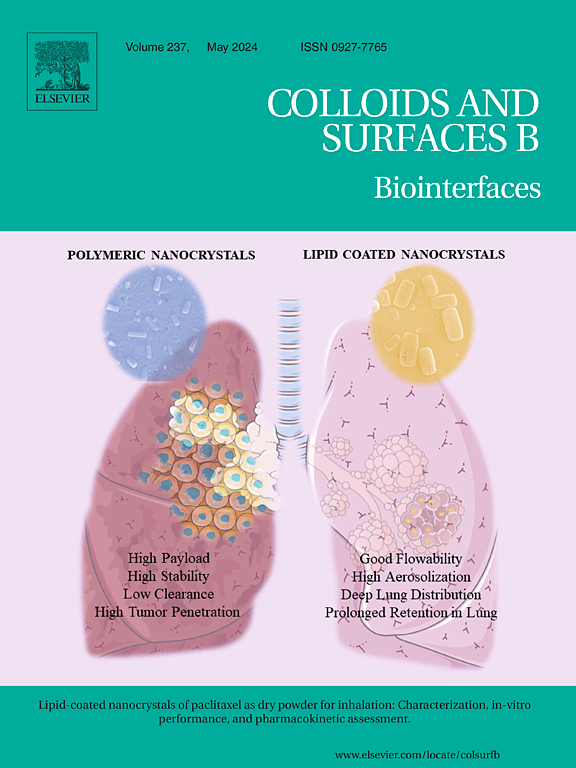Synergistic catecholamine and coordination chemistry for enhanced bioactivity and secondary grafting activity of zirconia dental implants
IF 5.4
2区 医学
Q1 BIOPHYSICS
引用次数: 0
Abstract
The inherent bioinertness of zirconia (ZrO2) hinders its early bone integration, presenting a significant obstacle to its widespread use in dental implant technologies. Addressing this, we developed a surface coating leveraging the synergistic effects of catecholamine and coordination chemistry inspired by the mussel byssus cuticle. This coating, named PDPA@Sr, is enriched with strontium ions and amine groups, resulting from a simple immersion of polydopamine (PD)-coated ZrO2 in an alkaline strontium chloride and poly(allylamine) (PA) solution. Compared to conventional mussel-inspired PD coatings, PDPA@Sr demonstrates enhanced aesthetic properties and mechanical stability. The continuous release of strontium ions from the coating significantly enhances osteogenesis, while the abundant surface amine groups offer notable antibacterial effects. More importantly, these amine groups also enable a variety of chemical modifications, including electrostatic adsorption, carbodiimide chemistry, Michael addition, Schiff base formation, and click chemistry, thus providing a multifaceted platform for the advanced surface modification of ZrO2 implants.
儿茶酚胺和配位化学协同增强氧化锆牙科植入物的生物活性和二次移植活性。
氧化锆(ZrO2)固有的生物惰性阻碍了其早期的骨整合,对其在牙科植入技术中的广泛应用构成了重大障碍。针对这一问题,我们开发了一种表面涂层,利用了儿茶酚胺和配位化学的协同作用,其灵感来自贻贝贝壳的角质层。这种被命名为 PDPA@Sr 的涂层富含锶离子和胺基团,是将涂有聚多巴胺 (PD) 的 ZrO2 简单浸泡在碱性氯化锶和聚烯胺 (PA) 溶液中产生的。与传统的贻贝启发型多巴胺涂层相比,PDPA@Sr 的美学特性和机械稳定性都有所提高。涂层中持续释放的锶离子可显著促进骨生成,而丰富的表面胺基团则具有明显的抗菌效果。更重要的是,这些胺基团还能进行多种化学修饰,包括静电吸附、碳化二亚胺化学、迈克尔加成、希夫碱形成和点击化学,从而为 ZrO2 植入物的高级表面改性提供了一个多元平台。
本文章由计算机程序翻译,如有差异,请以英文原文为准。
求助全文
约1分钟内获得全文
求助全文
来源期刊

Colloids and Surfaces B: Biointerfaces
生物-材料科学:生物材料
CiteScore
11.10
自引率
3.40%
发文量
730
审稿时长
42 days
期刊介绍:
Colloids and Surfaces B: Biointerfaces is an international journal devoted to fundamental and applied research on colloid and interfacial phenomena in relation to systems of biological origin, having particular relevance to the medical, pharmaceutical, biotechnological, food and cosmetic fields.
Submissions that: (1) deal solely with biological phenomena and do not describe the physico-chemical or colloid-chemical background and/or mechanism of the phenomena, and (2) deal solely with colloid/interfacial phenomena and do not have appropriate biological content or relevance, are outside the scope of the journal and will not be considered for publication.
The journal publishes regular research papers, reviews, short communications and invited perspective articles, called BioInterface Perspectives. The BioInterface Perspective provide researchers the opportunity to review their own work, as well as provide insight into the work of others that inspired and influenced the author. Regular articles should have a maximum total length of 6,000 words. In addition, a (combined) maximum of 8 normal-sized figures and/or tables is allowed (so for instance 3 tables and 5 figures). For multiple-panel figures each set of two panels equates to one figure. Short communications should not exceed half of the above. It is required to give on the article cover page a short statistical summary of the article listing the total number of words and tables/figures.
 求助内容:
求助内容: 应助结果提醒方式:
应助结果提醒方式:


